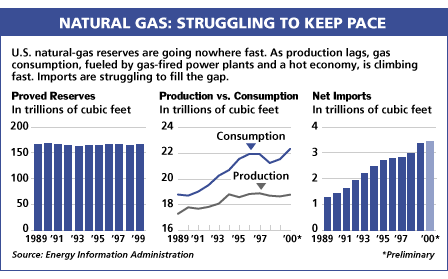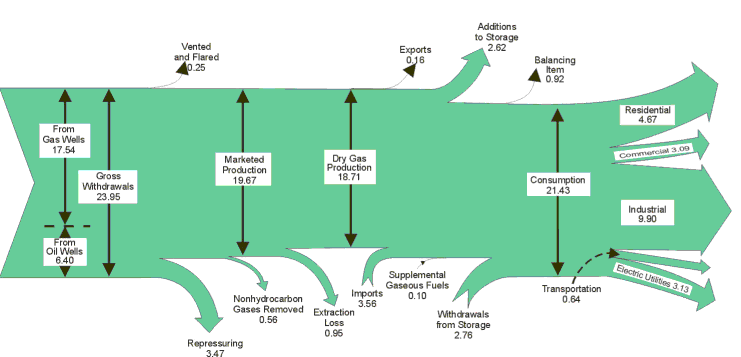Peak Natural Gas
gas fields deplete faster than oil fields
related pages:
- Liquid Natural Gas: dangerous terminals, limited supply, competition with Asian importers
- Shale Gas: exaggerated supplies, toxic "fracking" pollutes groundwater
this is why numerous terminals for Liquid Natural Gas importation have been proposed in the United States (West Coast, East Coast, Gulf of Mexico)
The best book about Natural Gas depletion is High Noon for Natural Gas by Julian Darley of the Post Carbon Institute.
“US natural gas production is declining despite a large increase in the number of producing wells . The US natural gas peak was at 22 Tcf/a in 1973 with about 100,000 wells; 2005 production was at 19 Tcf/a with 400,000 wells.”
-- Jean LaHerrere, ASPO-France
Methane Madness: A Natural Gas Primer
www.oilcrisis.com/gas/primer

www.reuters.com/newsArticle.jhtml?type=topNews&storyID=4380235
El Paso Trims Proven Reserves 41 Pct
Wed February 18, 2004 12:57 AM ET
Matt Daily
HOUSTON (Reuters) - Energy company El Paso Corp. said on Tuesday it had cut its proven natural gas reserves estimate by 41 percent and would take a $1 billion pretax charge in the fourth quarter.
In reducing its proven reserves estimates, the Houston-based company joined oil major Royal Dutch/Shell Group, which shocked investors last month by cutting its reserves estimates by 20 percent.
"Nobody's happy about the outcome of our year-end reserves. It's a big disappointment to say the least," Doug Foshee, El Paso's chief executive officer and president, said on a conference call.
El Paso confirmed late on Tuesday it hired law firm Haynes & Boone to examine the cause of the $1 billion write-down charge.
Burdened by about $24 billion in consolidated debt at the end of the third quarter, El Paso has struggled to return to health after failed ventures in the merchant electricity and telecoms businesses in recent years.
El Paso, which had warned investors earlier this month it would trim its estimates, cut its end-2003 estimates of proven reserves by 1.824 trillion cubic feet (tcf) of natural gas equivalent to 2.635 tcf equivalent.
Proven reserves are quantities of oil or gas that a company expects to be commercially recoverable from known fields from a given date.
The company, which is the largest U.S. natural gas pipeline operator, also warned investors it expected more write-down charges in 2004 as natural gas prices weakened.
KEEPS OUTPUT GOALS
El Paso said its January production averaged about 960 million cubic feet equivalent (MMcfe) per day, and it expected to meet its goal for average 2004 production of 850 MMcfe to 950 MMcfe production range based on its capital expenditure plans.
The company would not trim its $850 million capital expenditure program for 2004, Foshee said, although it was reviewing its spending and reducing investments in areas such as south Texas.
That was the region where reserves were trimmed the sharpest, followed by its coal bed methane operations and Gulf of Mexico production sites.
El Paso's energy production is focused on natural gas, which generated about five times the revenue of the company's oil output for the first nine months of 2003.
Production levels declined by 32 percent during that period, with drilling successes in about only one in five deep shelf wells.
Last month, El Paso hired Apache Corp's exploration and production vice president Lisa Stewart to head its production operations.
Foshee, who took the helm of El Paso in September, said the company remained on the path to recovery, and that its asset liquidation program remained on track to reach $3.3 billion to $3.9 billion by 2006.
On Monday, the company announced the sale of El Paso Oil and Gas Canada to UK's BG Group PLC for $345.6 million, bringing its asset sales to about $2.9 billion.
The company is scheduled to report fourth-quarter results on March 11.
(additional reporting by Sinead Carew in New York)
© Reuters 2004. All Rights Reserved.

Natural Gas consumption in the US - ca. 2000
What's that hissing sound?
Worried about oil running out?
Don't look now, but natural gas is next on the endangered hydrocarbons list.
By Jeff Nachtigal
from Salon.com
Aug. 10, 2004 | Oil prices hit an all-time high Monday, topping out at $44.97 a barrel. There are a bundle of immediate reasons -- sabotage and war in Iraq, the showdown between the Yukos Oil Co. and the Kremlin in Russia, political instability in Venezuela -- but there are also fundamental long-term forces pushing prices ever upward. Demand, particularly in countries such as India and China, is growing fast, but the supply is finite.
Still, among consumers in the United States, there appears to be little panic. The coming "oil peak" -- that moment when worldwide production of oil reaches its high point -- is in the news, but Detroit keeps turning out SUVs, freeways are perpetually jammed, and prices at the pump -- so far -- have not inspired many of us to cut back.
Our devil-may-care attitude about energy is fueled in large part by an economic principle of "substitutability," in which we depend on new sources of energy to take the place of the old. But when the oil spigots finally run dry -- whether in a few years or a few decades -- the next hydrocarbon on the list (and possibly the last, depending on how you count coal) will be natural gas. But if we blow through natural gas in the same reckless manner as we have oil, we're in for a serious shock, argues Julian Darley in his new book, High Noon for Natural Gas.
Darley is a self-described "environmental philosopher" who specializes in researching "non-market and non-technology-based responses to global environmental degradation." The primary thrust of High Noon for Natural Gas is that, unless we unplug as much as we can from our energy-dependent ways, we're headed off a cliff, and the crash at the bottom won't be pretty.
As with oil, gauging the peak of natural gas production is an inexact science. The best estimates suggest that oil production will hit its all-time high sometime between 2008 and 2035. But already, in 2002, the world discovered fewer reserves of untapped natural gas than it consumed that year -- a clear portent of eventual production declines.
Still relatively plentiful, natural gas will for some time fill the gap left by dwindling oil reserves. But if we move merrily on to the next readily available energy source without dramatically changing our gluttonous energy consumption habits, we will only be prolonging the inevitable, Darley says, and will end up throwing ourselves into the "carbon chasm."
Darley blames the uncontrollable growth of economies and global overpopulation as the two biggest drivers of energy consumption. His solution is to simply stop using nonrenewable energy -- to essentially opt out of the current energy infrastructure. He understands that his suggestions for dealing with the coming energy crisis will not be popular with the vast majority of Western society, nor for those living in fast-growing developing nations. But those who are aware of the problem, he argues, must start the long process of building a new, low-energy infrastructure to replace the current high-energy one we have now.
"The majority seems to act only when the avalanche is upon the roof; it is quite likely that no prediction, however accurate it is, will be sufficient to shift mainstream policy making or opinion," Darley writes. "Thus it is only those who think that we have already gone too far who will be willing to act, make the kinds of big changes required, and more than anything start building a new infrastructure while we can."
There are other problems with natural gas aside from its likely future scarcity. For example, the path from underground gas deposit to kitchen range is growing more complex, and expensive, as demand increases.
In the United States, nearly 70 percent of new buildings are heated with gas. Canada and Britain have similar numbers, and most of world is following suit and converting to natural gas heat. But most gas in the future will be used to produce electricity.
Because electricity is so intrinsic to our cities and life itself, Darley says, "anything that threatens the electricity supply is a direct threat to the lives of billions and billions of humans. So although natural gas may seem unrelated to the electricity user, problems with it are not."
Electricity is generated by coal, nuclear power, hydropower or natural gas. Natural gas currently powers about 20 percent of the United States' electricity plants, but that rate is sharply rising because low cost has made gas the fuel of choice. In 2003, more than 300 new gas-fired power stations were built, and 90 percent of new electricity plants are powered by gas.
Does it all make economic sense?
"In great part, the colossal rash of power station building has cost the United States precious time in trying to adjust to a landscape that will be seriously short of natural gas," Darley writes.
Adding to the problems is the greater difficulty of transporting natural gas than moving oil. Once gas is pumped out of the ground it travels by pipeline. But to move gas across oceans to U.S. markets requires freezing it into liquefied natural gas. LNG can then be transported by ocean tanker, but it requires expensive terminals in which to regasify the frozen liquid. The United States has 280,000 miles of gas pipeline, but it lacks adequate LNG terminals, the construction of which is now often contested by environmentally conscious communities.
It costs hundreds of millions to build one LNG terminal, and in combination with related piping infrastructure the cost can run over $1 billion. Building dozens of the required terminals will take care of U.S. demand for the short term, but it's a high price to pay if a gas peak lurks in the near future. LNG terminals also provide an easy target for terrorists, or in California's case, earthquakes. Opponents of a California-based terminal plan said that its vast stores of gas could turn into a mile-high fireball.
Even worse, "expansion in LNG (with its main production sources in politically anti-American states) threatens an even greater likelihood of endless war, covert disruption and forced regime change. For all these reasons all citizens of the U.S. should think very carefully before spending hundreds of billions of dollars and entering the global LNG market, one which may only last two or three decades anyway," Darley writes.
Darley touches briefly on alternative sources of energy, such as hydrogen, solar and wind, but discounts them as full-scale replacements for oil and gas because their implementation is too expensive.
So what can be done? Darley offers some small-scale steps for ordinary people to take, including turning off appliances, insulating homes, using cloth instead of plastic grocery shopping bags, wearing sweaters instead of cranking the heat up, and eating less meat (which requires far more energy to produce than plants).
But he's not a fan of moving to more "efficient" higher-technology appliances. "Efficiency," to Darley, is a distraction -- little more than a "code word for business-as-usual-lite." Saving energy through techno-fixes stokes economic growth and encourages increased energy use. Using significantly less energy by cutting energy out of our diet is the best way to scale back our overall energy dependence.
A few of Darley's suggestions border on the extreme and risk pushing the reader beyond the edge of present-day practicality. His recommendations include dismantling the industrial food system; limiting family size to one child; and "disconnecting from much of what has been built by industrialization and build a new infrastructure."
But other ideas seem within reach for many of us, such as buying food and goods from local producers and traveling by foot instead of car to bring about local "fuel to foot economies."
Darley says that North Americans, with their energy consumption, can make an enormous difference by just doing something. He also recognizes that self-sufficiency will come slowly and may never be entirely possible at a local level.
"It is, however, a good aim," he writes, "just as the goal of not using any hydrocarbons is the one that should guide us, even if we don't reach it very often, especially in the earlier stages."
About the writer Jeff Nachtigal is an editorial fellow at Salon.
Comments from readers:
HIGH NOON is a clearly written book about our Natural Gas predicament -- the only one I know of on this topic. Julian not only explains complex ideas and issues, he does so in a way that makes this book hard to put down. I learned a great deal about the types/reserves/formation of Natural Gas, coal bed methane, town/bio/landfill gas, pipelines, and so on. That in turn sets the stage for understanding natural gas on the world stage -- the politics, "economics", and enviromental aspects. I hope this is the first in a series explaining the issues with other energy sources, especially coal and nuclear, as these are the likely "fixes" the nation will turn to.
Alice, Oakland, CA
In the short run, natural gas will SEEM to be more abundant, at least in the Western US. We're improving our ability to store and distribute N.A. gas which, if we are lucky, may buy us an extra few years. (And don't forget the great number of drilling permits that have been issued.) The plan, of course, is to buy natural gas from China and Russia that is currently being flared off as incidental to the oil. We buy it at $0.50per MMBTU and then spend another $3.00 per MMBTU in refrigeration and transport to west coast LNG facilities. No need to tell you how many things have to go right for this scenario to actually come off, including an absence of terrorist activity.
None of this is to dispute Julian's main thesis, only to point put that it may be a tough sell in the short term.
Greg




